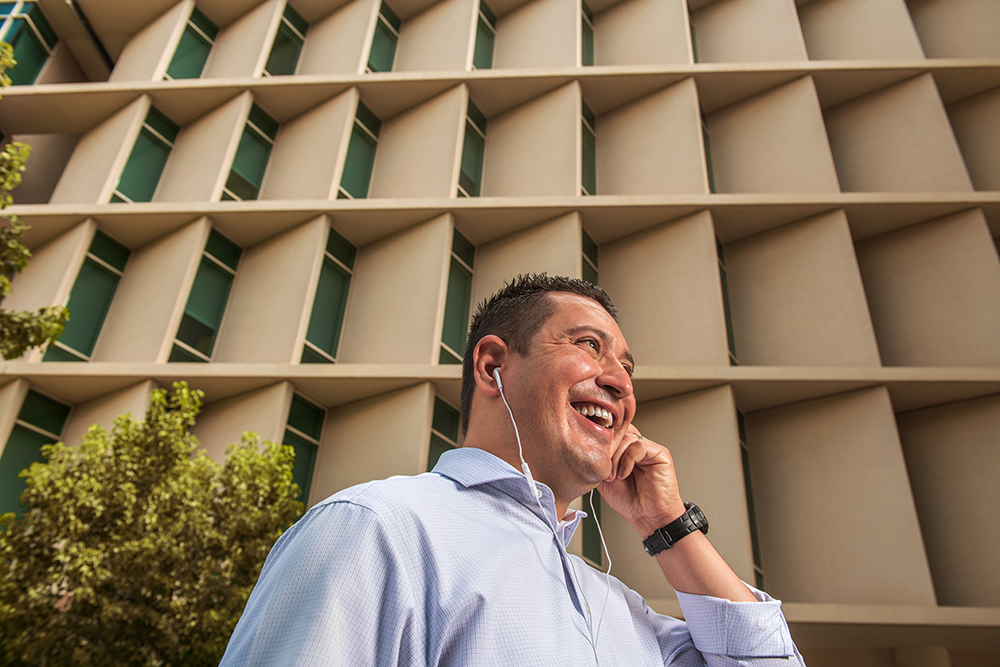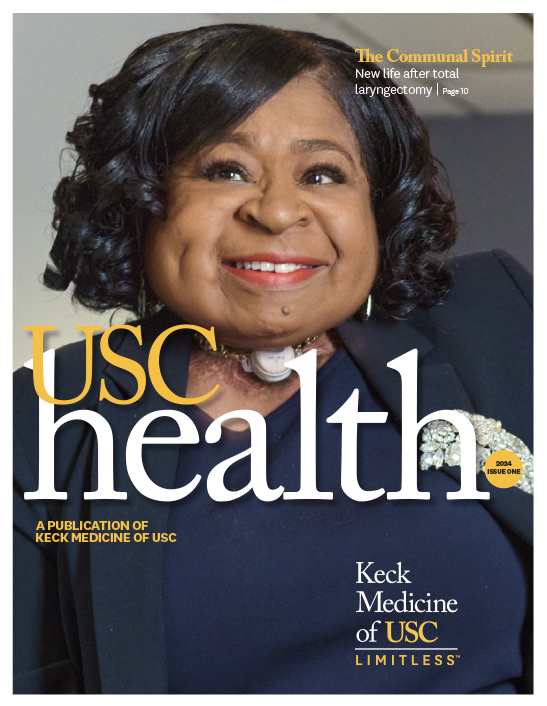
A delicate and complicated ear canal surgery helped Jake Valtierra his realize his dream: a chance to truly hear the music.
When Jake Valtierra awoke at Keck Hospital of USC in December 2020 from surgery to rebuild the inner workings of his right ear, for the first time the world was in beautiful surround sound — and it was, he says, “amazing.”
One of the first things he did: pop his ear buds into both ears and listen to “Thunder Road” by Bruce Springsteen.
“I can hear the lyrics word for word and recite them all day,” Jake says with pure joy. “Not only that, I can even turn down the volume and still hear!”
For Jake, 41, stereo hearing had eluded him until that moment, despite two previous surgeries.
Born without a functioning ear canal, and with a damaged ear drum and malformed middle ear bones, Jake was essentially deaf on his right side. He could feel vibrations but little else.
The condition is called congenital aural atresia, for the absence or abnormal narrowing of an opening or passage in the body.
Repairing it is “one of the most delicate surgeries we do,” says Jake’s surgeon, John Oghalai, MD, chair of the USC Caruso Department of Otolaryngology – Head and Neck Surgery at Keck Medicine of USC. “In fact, it’s so delicate that many ear specialists won’t even attempt it.”
Surgeons who don’t perform ear canal atresia surgery frequently offer the simpler alternative of a bone-anchored hearing aid, which vibrates the skull to conduct sound. But, like with any mechanical aid, the wearer can have hearing gaps.
“I like to be able to restore normal hearing,” Dr. Oghalai says. “I’ve been gratified by the results of my patients like Jake.”
Exploring options for pediatric ear surgery
Growing up in El Paso, Texas, Jake learned how to compensate for his hearing deficit. He sat close to the front of classrooms, avoided sports that might injure his head and tried to direct his left ear to anyone talking — not easy in a crowd. He felt off balance and occasionally left out.
Some children are born with bilateral atresia, with poorly or undeveloped ear canals, ear drums and middle ear bones on both sides.
For all children with atresia, whether unilateral or bilateral, the experts at the USC Caruso Department of Otolaryngology – Head and Neck Surgery recommend a speech and language evaluation by 2 years of age.
“Children can quickly miss normal milestones without healthy hearing,” Dr. Oghalai says. Because Jake had hearing on one side, his parents and pediatrician decided not to correct the problem of his faulty ear canal. It was a tricky surgery, after all.
By the time Jake reached his junior year in high school, his pediatrician’s son had started a medical residency in otolaryngology at Johns Hopkins University, and the conversation about Jake’s options expanded. The 17-year-old found himself meeting with the late surgeon John Niparko, MD, in Baltimore. It was December 1996.
Dr. Niparko partially opened up Jake’s right ear canal and removed tissue that blocked the canal and middle ear bones. Jake didn’t fully regain his hearing, but it was better than ever.
“With my earphones on, I could actually hear music in my right ear,” Jake remembers, “but I still couldn’t make out all the lyrics.”
Jake moved to California to earn his bachelor’s degree, then returned to Texas to get an MBA and start his career in education, first as a high school teacher, then moving on into school administration. But the clarity he had gained faded.

Multiple infections took their toll and, by 2014, he felt pressure on the right side of his head and debris spilled from his ear. “I got scared. I didn’t understand what was going on,” he recalls.
He tried to find a specialist in the El Paso area but the few who met with him said they didn’t feel comfortable taking on his case. He reached out to Dr. Niparko, and found the surgeon had moved to Los Angeles to head up the USC Caruso Department of Otolaryngology – Head and Neck Surgery.
Jake booked his ticket west and, 18 years after his first surgery, underwent a second procedure with Dr. Niparko, who again reopened the collapsed ear canal. With some hearing restored, Jake took a new job as a middle school assistant principal, married and began a family. This time, the sounds receded more quickly.
Surgery creates a new ear canal and ear drum
By 2020, as the COVID-19 pandemic hit, Jake’s right ear was again closing up. Jake called Keck Medicine, only to discover that Dr. Niparko had died a few years earlier. But Dr. Oghalai examined Jake’s record and saw signs he might be able to help him.
In October, Jake underwent a hearing test in Dr. Oghalai’s office. Jake couldn’t hear much with his right ear, but when Dr. Oghalai vibrated the skull with a hearing device, Jake suddenly heard extremely well.
“So, I knew his inner ear was functioning fine and we just had to get sound to that inner ear,” Dr. Oghalai says.
Two months later, Dr. Oghalai created a new ear canal and new ear drum for Jake, then lined the new canal with a skin graft from Jake’s thigh.
Getting my hearing back gives me more drive to keep pushing forward and see what lies ahead.
Jake Valtierra, patient, USC Caruso Department of Otolaryngology – Head and Neck Surgery
The surgeon also implanted an artificial middle ear bone to replace the malformed bones and connected everything with a titanium prosthesis to the cochlea, the spiral-shaped cavity of the inner ear that sends sound vibrations to the brain.
Jake didn’t stop his post-surgical celebration with Springsteen; he sampled AC/DC, Jack Johnson, Shakira and other favorite artists. All came through loud and clear.
Back home in Texas, he is enjoying every whisper of family life with wife Marissa and their kids Julian, Celina and Elijah.
At work, where he is now principal of an El Paso high school, he says, “I feel more empowered.” He no longer has to strategize where to sit in meetings to improve his odds of hearing or keep asking others to repeat things.
“I’m proud to be able to have helped him,” Dr. Oghalai says, “and to think that, by doing so, it will help him teach the next generation.”
“Getting my hearing back gives me more drive to keep pushing forward and see what lies ahead,” Jake says. “I have Dr. Oghalai and Keck Medicine to thank for that.”
Topics


